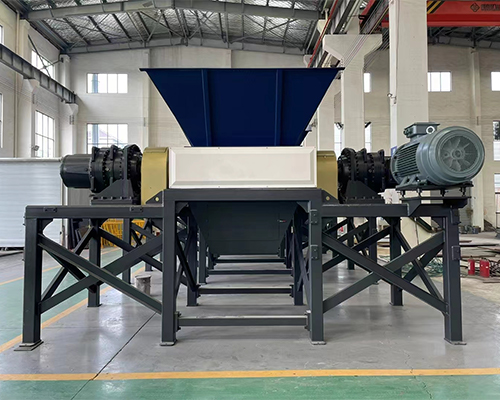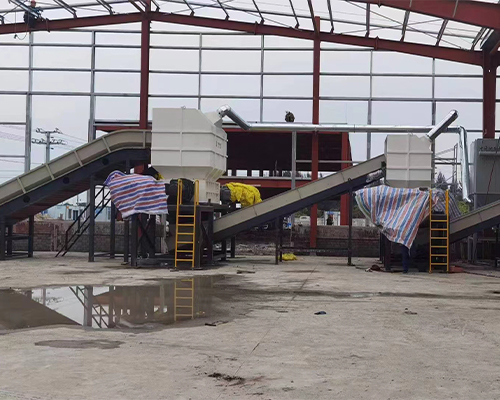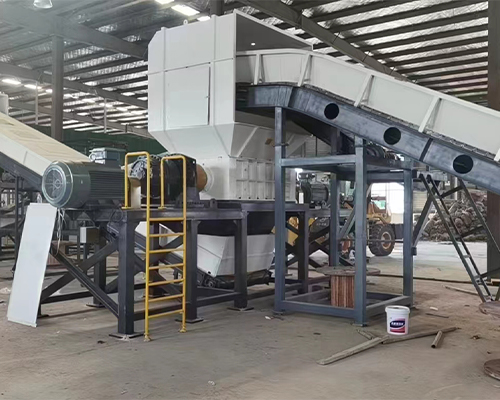How to choose dual shaft shredder?
Date:2024-11-01
View: Point
Choosing the right dual shaft shredder involves considering several key factors to ensure that the equipment meets your specific needs and provides the best cost-benefit ratio. Here’s a comprehensive guide to help you make an informed decision:

1. Material Type and Characteristics
- Material Type: Identify the primary materials you will be processing, such as scrap metal, plastic, wood, paper, etc. Different materials may require different types of blades and shredding methods.
- Material Hardness: Assess the hardness of the materials. Harder materials may need more robust blades and higher torque.
- Material Size and Shape: Determine the maximum size and shape of the materials to ensure the chosen shredder can handle them effectively.
2. Throughput Capacity
- Daily Processing Volume: Estimate the total amount of material you need to process daily. Choose a shredder with a capacity that meets or slightly exceeds this demand to handle peak times efficiently.
- Continuous Operation: Consider whether the shredder will need to operate continuously for long periods. If so, opt for a model with high reliability and durability.
3. Equipment Specifications
- Inlet Size: Ensure the shredder’s inlet size can accommodate your largest pieces of material.
- Output Particle Size: Determine the desired particle size of the shredded material. Some applications may require finer particles, while others can handle larger pieces.
- Motor Power: Select a motor power that matches your throughput and material hardness requirements to ensure efficient operation.
4. Technical Parameters
- Blade Material: High-quality blade materials, such as high-strength alloy steel, enhance durability and shredding efficiency.
- Number and Configuration of Blades: More blades and optimal configuration improve shredding performance and uniformity.
- Reducer Type: Choose the appropriate type of reducer (e.g., planetary, hard-toothed) to ensure smooth and energy-efficient operation.
5. Safety and Reliability
- Safety Features: Ensure the shredder has essential safety features such as emergency stop buttons, safety interlocks, and overload protection.
- Maintenance Accessibility: Select a shredder that is easy to maintain and clean to minimize downtime and maintenance costs.
- Brand and After-Sales Service: Opt for well-known brands that offer reliable technical support and after-sales service.
6. Cost-Benefit Analysis
- Initial Investment: Compare the prices of different brands and models to find the best value for money.
- Operating Costs: Consider ongoing costs such as energy consumption, maintenance, and blade replacement frequency.
- Return on Investment: Evaluate the economic benefits the shredder will bring, such as increased production efficiency and reduced labor costs.
7. Compliance and Standards
- Regulatory Compliance: Ensure the shredder meets local safety and environmental regulations.
- Certifications: Choose shredders that have international certifications like ISO to guarantee quality and performance.
8. User Reviews and Case Studies
- Customer Feedback: Read reviews and feedback from other users to understand real-world performance.
- Case Studies: Examine case studies from similar businesses to gain practical insights and success stories.
Practical Steps
- Consult Professionals: Engage with equipment suppliers or industry experts to get professional advice.
- Site Visits: Visit the supplier’s manufacturing facility or customer sites to see the equipment in action.
- Trial Period: If possible, request a trial period to test the shredder and verify its suitability for your needs.
By following these steps and considerations, you can select a dual shaft shredder that is well-suited to your specific needs and provides long-term value and efficiency.

| Model | 600 | 800 | 1000 | 1200 | 1400 | 1600 | 1800 |
| Motor(kw) | 11*2 | 18.5*2 | 35*2 | 45*2 | 55*2 | 75*2 | 110*2 |
Reducer | P6-P7 | P7-P8 | P8-P10 | P10-P12 | P11-P13 | P12-P16 | P14-P16 |
| Siemens or other motors, planetary reducers or other reducers can be customized according to customer requirements | |||||||
| Rotation Speed | 8-20rmp | 8-20rmp | 8-15rmp | 8-15rmp | 8-15rmp | 8-12rmp | 8-12rmp |
| Blades Diameter | 220-320 | 260-320 | 260-400 | 400-500 | 400-500 | 500 | 500 |
| Blades material | The material of the blades (55sicr, 5crsi, 9crsi, skd11, m6v, h13) can be customizedaccording to the customer's actual usage | ||||||
| Feeding Size | 1200*900mm | 1400*1000mm | 1600*1200mm | 1800*1300mm | 2000*1300mm | 2200*1700mm | 2400*2000mm |
| The size and appearance of the feeding hopper can be customized according to thecustomer's feeding situation | |||||||
| Weight(kg) | 1800 | 2500 | 3700 | 5500 | 7500 | 9500 | 13000 |

Zhongcheng Machinery Will Be There Whenever Wherever Whatever You Need
You Are Welcome to : phone call, Message, Wechat, Email& Seaching us, etc.
Email:
sales@zchmachinery.com
Whatsapp/Phone:
+8618738194110
hot Products
-
 Trommel screenTrommel screen, also known as drum screens, are widely used in various industries for sorting and separating materials.Get Quote
Trommel screenTrommel screen, also known as drum screens, are widely used in various industries for sorting and separating materials.Get Quote -
 Crop straw double shaft shreddApplications:Biomass Energy Production: Shredded straw can be used as a feedstock for bioenergy plants to produce electricity or heat.Livestock Feed: Reduced-si...Get Quote
Crop straw double shaft shreddApplications:Biomass Energy Production: Shredded straw can be used as a feedstock for bioenergy plants to produce electricity or heat.Livestock Feed: Reduced-si...Get Quote -
 Zhongcheng Air Drum SeparatorAir drum separators effectively separate lightweight materials (e.g., plastics, paper) from heavier materials (e.g., metals, glass). This high efficiency is cru...Get Quote
Zhongcheng Air Drum SeparatorAir drum separators effectively separate lightweight materials (e.g., plastics, paper) from heavier materials (e.g., metals, glass). This high efficiency is cru...Get Quote
relate news
-
2023-01-18RDF Making MachineRDF (Refuse Derived Fuel) making machine is a specialized equipment used in waste management and energy recovery processes. Its primary function is to convert v...
-
2024-06-09Advantages of Using Drum Screening Machines in Waste ManagementUnderstanding the working principle of drum screening machines is essential to appreciate their efficiency and effectiveness in waste management. Operation and ...
-
2024-08-06Plastic double shaft shredderOperation:Feeding: The plastic material is fed into the shredder through the infeed system.Shredding: As the material enters the shredding chamber, the rotating...
-
2025-03-03Mini Copper Wire GranulatorThe copper wire granulator machine is a device specially used to process waste wires and cables. Its main function is to separate the copper and plastic in the ...
-
2023-01-12Double-Shaft ShredderThe Double-shaft shredder is a widely used industrial shredder that efficiently processes various mixed waste materials, such as construction waste, industrial ...



